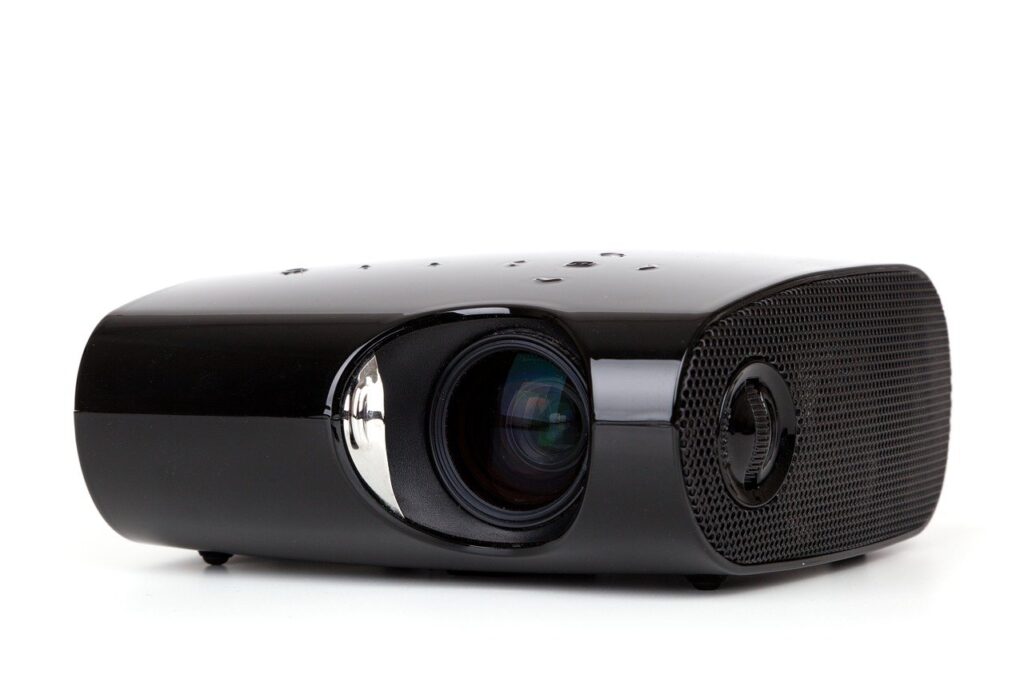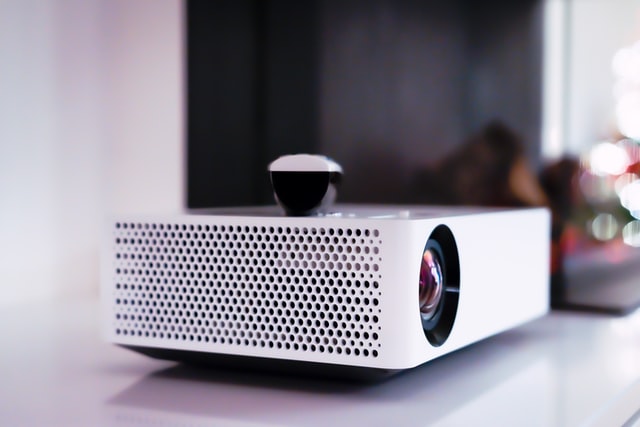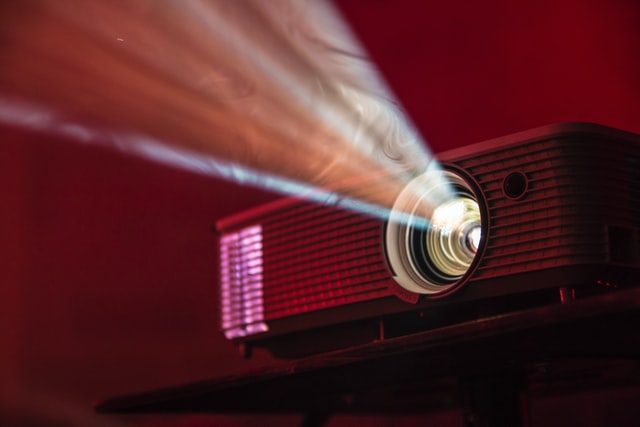The convenience and happiness that the projector brings will make you buy a great value. A white wall and opaque curtains can create a warm private theater. Let us watch movies at home anytime we want, and we don’t need to go to the theater anymore. The projector brings us so much convenience, how should we choose a suitable projector? When using a projector, how should we connect to the computer?
How to connect the projector to the computer?
- First of all, we must connect the video input interface of the projector to the video output interface of the laptop, and then on the projector. The current screen on the laptop will appear.
- Then, we can right-click to open the screen resolution option, here we click “Connect to Projector”.
- Then, we opened the relevant setting options. What we need to pay attention to is that we can use shortcut keys to operate, press the Microsoft logo key and the P key to quickly turn on the relevant settings displayed by the projector.
- If we select “Only computer” means that no image will be displayed on the projector, and the computer will not output images to the projector; if we select “The only projector”, then the computer will turn off the image on its monitor Output is conducive to energy saving under certain circumstances. As for copying, the resolution display output on the projector and the computer are the same; there is also an extended function, we can put the image output on one monitor on two monitors, or on these two different monitors. For different resolution adjustments, we need to adjust ourselves according to actual needs.
- Under normal circumstances, we use a projector to show PPT or some video documents. For specific settings, we can make different display adjustments in the screen resolution. Here you can refer to the setting process of your display.
What types of projectors are there available in market?
- CRT is the abbreviation of English Cathode Ray Tube, which means cathode ray tube. As an imaging device, this projector can decompose the input signal source into three colors of R, G, and B on the phosphor screen of the three CRT tubes. The phosphor is amplified and converged under the effect of high pressure, and the color is displayed on the large screen. The image, optical system, and CRT tube form a projection tube.
- LCD projection: LCD projectors adopt passive projection methods, which are divided into two types: liquid crystal light valve and liquid crystal panel projector. The key technology of liquid crystal projectors is the manufacture of liquid crystal panels. Liquid crystal panel LCD projectors use external light source metal halide lamps or UHP (cold light source) lamps as light sources.
- DLP projection: DLP is the abbreviation of “Digital Light Procession”, which means digital light processing. That is to say, this technology needs to digitally process the image signal, and then project the light. It is based on a digital micro-mirror component developed by TI (Texas Instruments).
- LCOS projection: LCOS (Liquid Crystal on Silicon) is a brand new digital imaging technology. It uses semiconductor CMOS integrated circuit chips as the substrate of reflective LCD. The CMOS chip is coated with a thin layer of liquid crystal silicon, and the control circuit is placed in the display device. In the back, the light transmittance can be increased, thereby achieving greater light output and higher resolution.
How to choose a projector ?
- The size of the space : The size of the space is the size of the living room, audio-visual room, etc. where you use the projector. If your living room area exceeds 20 square meters, you can consider buying a projector; if it is insufficient, it is not recommended. When viewing the projection screen, the distance between the projection screen and the sofa should be more than 4 meters, otherwise, the viewing effect will be poor and eyesight will be easily damaged.
- The price: The price of projectors has a large gap, generally ranging from a few thousand yuan to about 50,000 yuan, or even higher. The price of foreign brand products is higher than that of domestic products, and the price of domestic projectors is lower. For most consumers, products less than 500 USD can meet household needs. When buying a projector, try to find a more authorized agent to buy it. Because the projector is more profitable, it is no problem to boldly bargain 8% for a product with a price of 300-400 USD.
- Brightness: Brightness is one of the most important indicators to buy a projector. Now the price of projectors is getting lower and lower, and the brightness is getting higher and higher. Products with 2,000 lumens have become popular. But do home projectors need such high brightness? A high-brightness projection screen, if viewed for a long time, will damage eyesight. In fact, in the case of low background light, an 800 lumens projector can already meet the needs. If it is not in the daytime or at home when the lights are brightly lit, then 800-1000 lumens of products are enough, even if the background light is slightly brighter, 1200 lumens of products are enough.
- noise: I have never used a projector, and I don’t understand that the projector will make noise when it is used. The noise of some projectors will be severe to watch, making people intolerable. When buying a projector, consider low noise should be an important item in the purchase. At present, many manufacturers have launched low-noise projectors, and the price is not expensive. Generally speaking, products with a noise below 40dB are acceptable, but when purchasing, you should listen and compare in a quiet environment to see if it interferes with yourself.
- DLP or LCD: Whether it is LCD or DLP is not that important. What we need to look at is the effect of the projector, and the effect of a projector is inseparable from many things such as the lens, light bulb, and circuit. In principle, LCD projectors are the most common, and the price is correspondingly lower.
- The biggest advantage of the LCD projector is that the colors are great. The three primary colors of red, green, and blue are completed by 3 separate LCD panels, which can control the brightness and Contrast of each color individually, and the three colors can reach the screen almost at the same time, So various colors can be reproduced truly.
- Although the color reproduction of the DLP projector is slightly inferior, because the three colors of the single-chip DLP projector are reflected to the same pixel by the same micromirror, there is no convergence problem, so the black area is truly black, and the edge of the pixel is not.
- There will be some burrs and shadows in the LCD, so when showing some thin lines, DLP projectors are clearer and sharper than LCD projectors, black and white are purer, and gray levels are richer.
- The biggest advantage of a single-chip DLP projector is its small size and lightweight. Many products are even only 1-2 kilograms. Generally speaking, DLP projectors are slightly more expensive.
- Seeing is believing, whether it is LCD or DLP, it is recommended to compare carefully when purchasing.
- keystone correction: In the use of the projector, the position of the projector should be at right angles to the projection screen as much as possible to ensure the projection effect. If the verticality of the two cannot be guaranteed, the picture will be trapezoidal.
- If it is not hoisted, but placed on the table, it is difficult for us to ensure “vertical”. In this case, we need to use the “keystone correction function” to correct the trapezoid to ensure that the picture becomes a standard rectangle.
- There are usually two methods of keystone correction: optical keystone correction and digital keystone correction.
- Optical keystone correction refers to the purpose of adjusting the trapezoid by adjusting the physical position of the lens
- Another type of digital keystone correction is to achieve keystone correction by software.
- At present, almost all projector manufacturers have adopted digital keystone correction technology, and most projectors that use digital keystone correction support vertical keystone correction, that is, the projector can adjust its height in the vertical direction.
- Trapezoid, the vertical trapezoid correction by the projector can make the picture into a rectangle, thus facilitating the user’s use. Few new products do not have keystone correction, and the price is not so expensive. But some old machines don’t have it. When purchasing, you need to pay attention to whether the purchased machine has this function. At the same time, when showing at home, although the keystone correction is not used, after the image is corrected, some lines and character edges of the picture will appear burrs and unevenness, which makes the projection effect not particularly ideal.
How to use the projector: how to connect to a notebook ?
- Note that the VGA signal cable must be tightened, otherwise the projected image may have a color cast problem. If the problem is not solved after tightening, you can try to replace the cable. In addition, after connecting the VGA signal cable, if you need to use the remote control to operate the computer, you must also connect the signal control cable.
- General users will set the 17-inch CRT monitor to 1024*768@85 or higher resolution and refresh rate, but when using a video splitter to connect the monitor and the projector at the same time, you should pay attention to the resolution and refresh rate. set up. When the projector prompts that the input signal is out of range, the resolution and refresh rate of the graphics card should be appropriately reduced, otherwise, the projector cannot recognize the image.
- In addition, the projector must be paired with the computer to get the best projection effect. For example, if the resolution of the projector is relatively high, a computer that supports high resolution must be used to match it. In addition to desktop computers, projectors are more connected to laptops, especially after the emergence of portable projectors, the combination of laptops and projectors has become another choice for mobile office workers.
- Notebooks generally provide a D-Sub 15-pin VGA output interface, plus its LCD, so there is no need to use a video splitter to connect, but you need to pay attention to the output mode. Notebook computers generally provide three output modes: LCD screen output only, Only the VGA port output and the LCD screen and the VGA port are output at the same time, the default state is only the LCD output, so when connecting the projector, you need to change the output mode of the notebook.



